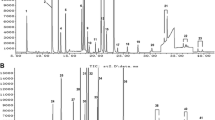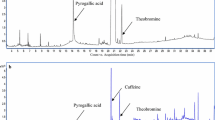Abstract
A highly reliable, quantitative and sensitive analytical method for determining the residues of the fungicide, hexaconazole in black tea is described. The proposed method is based on liquid-liquid extraction followed by gas chromatographic determination, using nitrogen phosphorus detector (GC-NPD) for the identification and quantitation of hexaconazole. The most appropriate solvent mixture for extracting hexaconazole residues from black tea was n-hexane:acetone at 1:1 (v/v). The extract was cleaned up by adsorption column chromatography using activated florisil. Performance of the method was assessed by evaluating quality parameters such as recovery value, repeatability, reproducibility, linearity and limits of detection and quantitation. When the method was assessed for repeatability, the percentage of recovery ranged between 86% and 96% while the relative standard deviation was between 0.30% and 2.35%. In studies on reproducibility the recovery ranged from 81% to 85% and relative standard deviation from 1.68% to 5.13%, implying that the method was reliable. A field trial was conducted to verify the application of this method with real samples. Results prove that the validated method was suitable for extracting hexaconazole residues.
Similar content being viewed by others
References
Bernal, J.L., del Nozal, M.J., Jimenez, J.J., Rivera, M.J., 1997. Matrix effects in the determination of acaricides and fungicides in must by gas chromatography with electron capture and nitrogen phosphorus detection. J. Chromatogr. A, 778(1–2):111–117. [doi:10.1016/S0021-9673(97)00214-8]
Garland, S.M., Menary, R.C., Davies, N.W., 1999. Dissipation of propiconazole and tebuconazole in peppermint crops (Mentha piperita (Labiatae)) and their residues in distilled oils. J. Agric. Food Chem., 47(1):294–298. [doi:10.1021/jf980120e]
Kumar, V., Ravindranath, S.D., Shanker, A., 2004. Fate of hexaconazole residues in tea and its behavior during brewing process. Chemical Health and Safety, 11(1):21–25. [doi:10.1016/j.chs.2003.09.018]
Manikandan, K.N., Karthika, C., Muraleedharan, N., Seenivasan, S., Selvasundaram, R., 2006. Studies on the residues of copper and hexaconazole during their combined application and their subsequent transfer into tea infusion. J. Plant Crop, 34(3):405–409.
Otero, R.R., Grande, B.C., Gandara, J.S., 2003. Multiresidue method for fourteen fungicides in white grapes by liquid-liquid and solid-phase extraction followed by liquid chromatography-diode array detection. J. Chromatogr. A, 992(1–2):121–131. [doi:10.1016/S0021-9673(03)00317-0]
Premkumar, R., Baby, U.I., 2005. Blister blight control—A review of current recommendations. Planter’s Chronicle, 101(5):26–34.
Ramasamy, V., 1996. CTC Tea Manufacture. The United Planters Association of Southern India, Coonoor, p.1–68.
Sannino, A., 2004. Evaluation of a method based on liquid chromatography/electrospray tandem mass spectrometry for analyzing eight triazolic and pyrimidine fungicides in extracts of processed fruits and vegetables. J. AOAC Int., 87(4):991–996.
Schermerhorn, P.G., Golden, P.E., 2005. Determination of 22 triazole compounds including parent fungicides and metabolites in apples, peaches, flour and water by liquid chromatography/tandem mass spectrometry. J. AOAC Int., 88(5):1491–1502.
Trosken, E.R., Bittner, N., Volkel, W., 2005. Quantitation of 13 azole fungicides in wine samples by liquid chromatography-tandem mass spectrometry. J. Chromatogr. A, 1083(1–’2):113–119. [doi:10.1016/j.chroma.2005.06.020]
Zambonin, G., Cilenti, A., Palmisano, F., 2002. Solid-phase micro extraction and gas chromatography-mass spectrometry for the rapid screening of triazole residues in wine and strawberries. J. Chromatogr. A, 967(2):255–260. [doi:10.1016/S0021-9673(02)00780-X]
Zanella, R., Primel, E.G., Goncalves, F.F., Martins, A.F., 2000. Development and validation of a high performance liquid chromatographic method for the determination of clomazone residues in surface water. J. Chromatogr. A, 904(2):257–262. [doi:10.1016/S0021-9673(00)00912-2]
Author information
Authors and Affiliations
Corresponding author
Rights and permissions
About this article
Cite this article
Karthika, C., Sachin, P.J. Gas chromatographic method for the determination of hexaconazole residues in black tea. J. Zhejiang Univ. Sci. B 9, 160–164 (2008). https://doi.org/10.1631/jzus.B0720262
Received:
Accepted:
Issue Date:
DOI: https://doi.org/10.1631/jzus.B0720262




